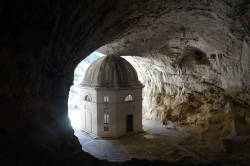Tempio del Valadier - Santa Maria di Frasassi - Infrasaxa
Grotte di Frasassi
Useful Information

| Location: |
Leave Autostrada A14 at exit Ancona Nord, follow Superstrada (dual carriagway) towards Rome for 45 km to exit Genga/Sassofarrato.
Follow signposts towards Genga.
About 500 m behind the entrance to Grotta Grande del Vento, parking right.
800 m walk and 150 m ascend.
(43.402967423546656, 12.954470374968041) |
| Open: |
no restrictions. [2007] |
| Fee: |
free. [2007] |
| Classification: |
 Karst Cave Karst Cave
 Cave Church. Cave Church.
|
| Light: | bring torch |
| Dimension: | |
| Guided tours: | self guided cave trekking tours to the cave |
| Photography: | allowed |
| Accessibility: | yes |
| Bibliography: | |
| Address: |
Grotte di Frasassi, Largo Leone XII°, I-60040 Genga, (Ancona), Tel: +39-0732-97211.
Grotte di Frasassi, Consorzio Frasassi, I-60040 Genga, Ancona, Italia, Tel: +39-0732-973039 or 973001, Fax +39-0732-973397. |
| As far as we know this information was accurate when it was published (see years in brackets), but may have changed since then. Please check rates and details directly with the companies in question if you need more recent info. |
|
History
| 1029 | first written mention of the Sanctuary of Santa Maria infra Saxa. |
| 1828 | octagonal temple commissioned by Pope Leo XII. |
Description
This site is a complex of caves and cave churches, which gave all the caves of this area the collective name Grotte di Frasassi (the plural is intended!). Frasassi is not a town, but the place, or better the name of one church.
A natural cave entrance called Grotta del Santuario with a small church inside gave the area its modern name. This church was called Santa Maria intra saxa in Medieval Latin or infrasaxa which means in the rocks. This name was difficult for the locals, and so it was modified from infra saxa to in frasassi over the centuries. This church is really small, and was built under a small overhanging rock at the far end of the huge cave portal. It was originally built by Benedictine monks to house a burned image of the Madonna.
This exceptional place is located in the Gola di Frassasi (Gorge of Frasassi), a narrow gorge between Genga railroad station and Genga. At the railroad station is the huge parking lot of the Grotta Grande del Vento, the impressive show cave. Driving into the gorge we reach the show cave entrance, built into the steep rock walls of the gorge. It is easy to understand, why they built the parking lot outside the gorge, there is absolutlely no room, even the bus station is narrow and short. But following the gorge, the road crosses the river and there is a parking lot on the right side. Here a wide, paved, but steep road to the cave churches starts. It is a little strenuous, 20 minutes walk uphill, but it is really worth the effort. The road is rather new, it was built - replacing the narrow old path - in the 19th century, for building materials and pilgrims.
At the end of the path we reach a sort of amphitheatre high up in the middle of the vertical cliff face. The first cave entrance is really huge with an octagonal chapel built inside. Then there is a second portal with a short cave which goes in only 50 m. At the far end is the small chapel we already described above.
The huge portal is called Grotta della Beata Vergine di Frasassi and is the entrance to the Grande Antro del Mezzogiorno. The octagonal chapel is called Tempio del Valadier or Tempietto di Valadier as it was built by the Italian architect Giuseppe Valadier. He was a chief exponent of Neoclassicism in Italy. It was commissioned by Pope Leone XII (*1760-✝1829), whose former name was Annibale Sermattei and who originated from Genga. After he became pope in 1823 he tried to develop his old home town. He also developed the agriculture of the area.
The chapel has an exception octagonal form, was built of travertine, redeposited limestone from karst water, which was quarried inside the cave behind. It has a roof, not really necessary inside the cave, which is a cupola covered by lead. The altar was made of alabaster, and the statue of Mary with the Child was made of Carrara marble by Antonio Canova. It is today in the civic museum of Genga, the statue in the temple is a replica. During the construction of the chapel a lot of cave sediments were removed. There was no archaeological excavation but the discovery of various human remains, probably of prehistoric origin, was noted. There were the bones of several humans, including children, ovens for baking bread, two stores of grains, and some coins. Obviously the coins were from the Bronze or Iron Age. Pagnani described the findings and interpreted them as the remains of people who sought refuge from the "raids of Barbarians, especially the Ungheri". The findings are on display in the Museo Archeologico Nazionale delle Marche di Ancona (National Archaeological Museum of the Marches in Ancona).
The cave behind the temple is a huge system and is guided by the show cave administration on cave trekking trips. So it is rather common to see groups of cavers in overall, helmet and rubber boots to enter the cave, or leave it after a several hours long trip. The cave has various entrances and is toured as a through cave.
 Search DuckDuckGo for "Tempio del Valadier"
Search DuckDuckGo for "Tempio del Valadier" Google Earth Placemark
Google Earth Placemark Sanctuary of Santa Maria infra Saxa, Genga (visited: 01-JUN-2021)
Sanctuary of Santa Maria infra Saxa, Genga (visited: 01-JUN-2021) Index
Index Topics
Topics Hierarchical
Hierarchical Countries
Countries Maps
Maps